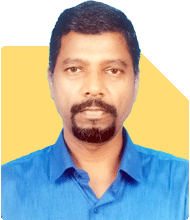Dr Nagarajan J S K |2575 Answers |Ask -Follow
NEET, Medical, Pharmacy Careers - Answered on Nov 01, 2024
He has over 30 years of experience in counselling students towards making the right career choices, particularly in the field of pharmacy.
As the JSS College placement officer, he has helped aspiring professionals prepare for and crack job interviews.
Dr Nagarajan holds a PhD in pharmaceutical sciences from the JSS Academy of Higher Education And Research, Mysore, and is currently guiding five PhD scholars.... more

Im scared can i crack neet 2025 or not , i have been addicted to character ai too , i studied but still has some backlog too and my score is around 400 only . Idk what to do , please suggest
You have scored more than 50%. Now, identify the areas where you missed points and, specifically, which subjects need your attention. Since you are going to repeat the exam, it's helpful to focus on the topics you struggle with. I have interacted with some of my students who were not eligible for NEET, and they overlooked a few fundamental concepts. Be strong in these areas, as many of the questions are from NCERT books. Prepare accordingly, and I'm confident you can score more than 700. Give it your best effort!
All the best!
You may like to see similar questions and answers below
Mayank Chandel |2562 Answers |Ask -Follow
IIT-JEE, NEET-UG, SAT, CLAT, CA, CS Exam Expert - Answered on Jun 10, 2024
Parthiban T R | Answer |Ask -Follow
Career Counsellor - Answered on Jul 30, 2024
Mayank Chandel |2562 Answers |Ask -Follow
IIT-JEE, NEET-UG, SAT, CLAT, CA, CS Exam Expert - Answered on Aug 27, 2024
Dr Nagarajan J S K |2575 Answers |Ask -Follow
NEET, Medical, Pharmacy Careers - Answered on Jul 06, 2025
Dr Dipankar Dutta |1837 Answers |Ask -Follow
Tech Careers and Skill Development Expert - Answered on Dec 05, 2025
Dr Shyam Jamalabad |108 Answers |Ask -Follow
Dentist - Answered on Dec 05, 2025
Dr Shyam Jamalabad |108 Answers |Ask -Follow
Dentist - Answered on Dec 05, 2025
Dr Shyam Jamalabad |108 Answers |Ask -Follow
Dentist - Answered on Dec 05, 2025
Dr Dipankar Dutta |1837 Answers |Ask -Follow
Tech Careers and Skill Development Expert - Answered on Dec 05, 2025
Ulhas Joshi |280 Answers |Ask -Follow
Mutual Fund Expert - Answered on Dec 05, 2025
Dr Dipankar Dutta |1837 Answers |Ask -Follow
Tech Careers and Skill Development Expert - Answered on Dec 04, 2025
Ravi Mittal |676 Answers |Ask -Follow
Dating, Relationships Expert - Answered on Dec 04, 2025
Anu Krishna |1745 Answers |Ask -Follow
Relationships Expert, Mind Coach - Answered on Dec 04, 2025
Anu Krishna |1745 Answers |Ask -Follow
Relationships Expert, Mind Coach - Answered on Dec 04, 2025



























